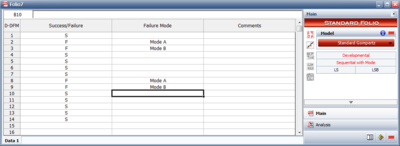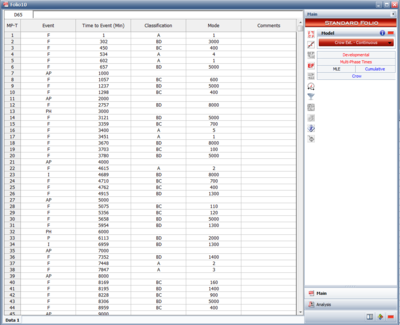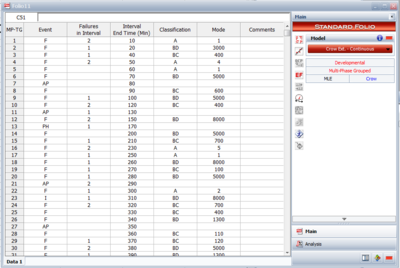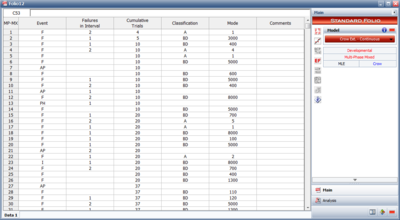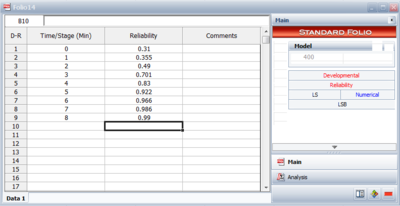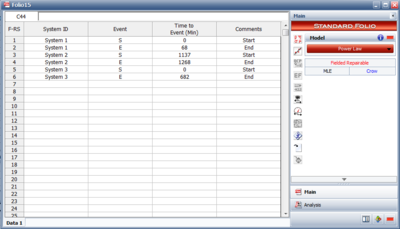RGA Data Types
Reliability growth analysis can be conducted using different data types. This chapter explores and examines the possible data schemes and outlines the available models for each data type. The data types for developmental testing (traditional reliability growth analysis) will be discussed first. Then we will discuss the data types that support the use of RGA models for analyzing fielded systems (either for repairable systems analysis or fleet data analysis).
Developmental Testing Data Types
Reliability growth analysis can be conducted using different data types. This chapter explores and examines the possible data schemes and outlines the available models for each data type. The data types for developmental testing (traditional reliability growth analysis) will be discussed first. Then we will discuss the data types that support the use of RGA models for analyzing fielded systems (either for repairable systems analysis or fleet data analysis).
Developmental Testing Data Types
Template loop detected: Template:Time-to-failure data
Discrete Data
Discrete data is also referred to as success/failure or attribute data. It involves recording data from a test for a unit when there are only two possible outcomes: success or failure. An example of this is a missile that gets fired once and it either succeeds or fails. The data types available for analyzing discrete data with the RGA software are:
- • Sequential
- • Sequential with Mode
- • Grouped per Configuration
- • Mixed Data
Sequential Data
For Sequential data, an item is tested with only two possible outcomes: success or failure. This could be a one-shot item such as a missile or an entire system that either succeeds or fails. The item is then inspected after each trial and redesigned/repaired before the next trial. Figure Sequential shows an example of this data type, where the row number in the data sheet represents the sequence of the trials. In this data set, trial #1 succeeded, trial #2 failed, and so on.
Sequential with Mode Data
Often after failure analysis you know the reason for failure during a particular trial. If this is the case, the reason for each failure can also be used in the analysis. This data entry is identical to the Sequential data with the exception that a failure code, mode or ID is added after each failure so that the analysis can take into account different failure modes. Figure SequentialMode shows an example of this type of data.
Grouped per Configuration Data
This data type is used when multiple items, instead of a single item, are tested and the number of units that fail are recorded for each configuration. The row numbers that appear on the left side of the Data Entry Spreadsheet, shown in Figure GroupConfig, represent the unique configurations. For example, row 1 indicates configuration 1 in which 10 missiles were fired and 5 failed, row 2 indicates configuration 2 in which 8 missiles were fired and 3 failed, etc. The data can be cumulative or non-cumulative.
Mixed Data
The mixed data type can have input data that is either configuration in groups or individual trial by trial, or a mixed combination of individual trials and configurations of more than one trial. Figure Mixed data shows an example of this data type. For example the first row of this data sheet shows that three failures occurred in the first four trials, the second row shows that there was no failure in the next trial while the third row shows that three failures occured in the next four trials
Models for Discrete Data
The following models can be used to analyze discrete data. Models and examples using the different data types are discussed in later chapters.
1) Duane (Chapter 4)
2) Crow-AMSAA (NHPP) (Chapter 5)
3) Crow Extended (Chapter 9)
4) Lloyd-Lipow (Chapter 6)
5) Gompertz and Modified Gompertz (Chapter 7)
6) Logistic (Chapter 8)
Multi-Phase Data
Reliability data can be analyzed across multiple phases. This is useful when an overall reliability growth program is planned and involves multiple test phases.
(Multi-Phase) Failure Times Data
This data type can be used for tests that span multiple phases and the exact failure times are recorded. Figure CECETF shows an example of multi-phase failure times data, where the different events signify failures (F), test phases (PH) or analysis points (AP).
(Multi-Phase) Grouped Failure Times Data
This data type can be used for tests that span multiple phases and the exact failure times are unknown. Only the number of failures within a time interval are recorded, as shown in Figure CECErouped.
(Multi-Phase) Mixed Data
This data type can be used for tests that span multiple phases and it allows for configuration in groups, individual trial by trial, or a mixed combination of individual trials and configurations of more than one trial. An example of this data type can be seen in Figure Multi-phase mixed data.
Models for Multi-Phase Data
The Crow Extended - Continuous Evaluation model is used to analyze data across multiple phases and is presented in Chapter 10.
Reliability Data
Reliability data consists of entering the reliability of the equipment at different times or stages. An example is shown in Figure Reliability. In this case, the process is monitored at pre-defined time intervals and the reliability is recorded. The reliability can be computed by a simple ratio of the number of units still functioning vs. the number of units that entered the test stage or by using Life Data Analysis and related methods (e.g. Weibull analysis).
Models for Reliability Data
The following models can be used to analyze reliability data sets. Models and examples using different data types are discussed in later chapters.
1) Lloyd-Lipow (Chapter 6)
2) Gompertz and Modified Gompertz (Chapter 7)
3) Logistic (Chapter 8)
Fielded Systems
Fielded systems are systems that are used by customers in the field and for which failure information is not derived from an in-house test. This type of data is analogous to warranty data. The data types available for fielded systems data entry are:
- Repairable Systems
- Fleet
Repairable Systems
Repairable Systems data is identical in format to the Multiple Systems (Concurrent Operating Times) data. It also can be entered in the normal or advanced view. Figure Repair illustrates a sample data set. In repairable systems, the purpose of the analysis is not to evaluate reliability growth but rather to obtain reliability estimates for the system, including expected number of failures, reliability at a given time, and so forth.
Models for Repairable Systems Data
The following models can be used to analyze repairable systems data. Models and examples using different data types are discussed in Chapter 13.
1) Power Law
2) Crow Extended
Fleet Data
This data type is used to analyze the entire population (fleet). The data entry for this data type is similar to the data entry for repairable systems; however, the overall data analysis is again different. In repairable systems, the reliability of a single system can be tracked and quantified, whereas in a fleet analysis, data from the entire fleet as a whole is analyzed. The figure below presents an example of data entered for fleet analysis. Models for Fleet Data
The following models can be used to analyze fleet data. Models and examples using different data types are discussed in later chapters.
- Crow-AMSAA (NHPP)
- Crow Extended
<INSERT PIC>
Discrete Data
Discrete data is also referred to as success/failure or attribute data. It involves recording data from a test for a unit when there are only two possible outcomes: success or failure. An example of this is a missile that gets fired once and it either succeeds or fails. The data types available for analyzing discrete data with the RGA software are:
- • Sequential
- • Sequential with Mode
- • Grouped per Configuration
- • Mixed Data
Sequential Data
For Sequential data, an item is tested with only two possible outcomes: success or failure. This could be a one-shot item such as a missile or an entire system that either succeeds or fails. The item is then inspected after each trial and redesigned/repaired before the next trial. Figure Sequential shows an example of this data type, where the row number in the data sheet represents the sequence of the trials. In this data set, trial #1 succeeded, trial #2 failed, and so on.
Sequential with Mode Data
Often after failure analysis you know the reason for failure during a particular trial. If this is the case, the reason for each failure can also be used in the analysis. This data entry is identical to the Sequential data with the exception that a failure code, mode or ID is added after each failure so that the analysis can take into account different failure modes. Figure SequentialMode shows an example of this type of data.
Grouped per Configuration Data
This data type is used when multiple items, instead of a single item, are tested and the number of units that fail are recorded for each configuration. The row numbers that appear on the left side of the Data Entry Spreadsheet, shown in Figure GroupConfig, represent the unique configurations. For example, row 1 indicates configuration 1 in which 10 missiles were fired and 5 failed, row 2 indicates configuration 2 in which 8 missiles were fired and 3 failed, etc. The data can be cumulative or non-cumulative.
Mixed Data
The mixed data type can have input data that is either configuration in groups or individual trial by trial, or a mixed combination of individual trials and configurations of more than one trial. Figure Mixed data shows an example of this data type. For example the first row of this data sheet shows that three failures occurred in the first four trials, the second row shows that there was no failure in the next trial while the third row shows that three failures occured in the next four trials
Models for Discrete Data
The following models can be used to analyze discrete data. Models and examples using the different data types are discussed in later chapters.
1) Duane (Chapter 4)
2) Crow-AMSAA (NHPP) (Chapter 5)
3) Crow Extended (Chapter 9)
4) Lloyd-Lipow (Chapter 6)
5) Gompertz and Modified Gompertz (Chapter 7)
6) Logistic (Chapter 8)
Multi-Phase Data
Reliability data can be analyzed across multiple phases. This is useful when an overall reliability growth program is planned and involves multiple test phases.
(Multi-Phase) Failure Times Data
This data type can be used for tests that span multiple phases and the exact failure times are recorded. Figure CECETF shows an example of multi-phase failure times data, where the different events signify failures (F), test phases (PH) or analysis points (AP).
(Multi-Phase) Grouped Failure Times Data
This data type can be used for tests that span multiple phases and the exact failure times are unknown. Only the number of failures within a time interval are recorded, as shown in Figure CECErouped.
(Multi-Phase) Mixed Data
This data type can be used for tests that span multiple phases and it allows for configuration in groups, individual trial by trial, or a mixed combination of individual trials and configurations of more than one trial. An example of this data type can be seen in Figure Multi-phase mixed data.
Models for Multi-Phase Data
The Crow Extended - Continuous Evaluation model is used to analyze data across multiple phases and is presented in Chapter 10.
Reliability Data
Reliability data consists of entering the reliability of the equipment at different times or stages. An example is shown in Figure Reliability. In this case, the process is monitored at pre-defined time intervals and the reliability is recorded. The reliability can be computed by a simple ratio of the number of units still functioning vs. the number of units that entered the test stage or by using Life Data Analysis and related methods (e.g. Weibull analysis).
Models for Reliability Data
The following models can be used to analyze reliability data sets. Models and examples using different data types are discussed in later chapters.
1) Lloyd-Lipow (Chapter 6)
2) Gompertz and Modified Gompertz (Chapter 7)
3) Logistic (Chapter 8)
Fielded Systems
Fielded systems are systems that are used by customers in the field and for which failure information is not derived from an in-house test. This type of data is analogous to warranty data. The data types available for fielded systems data entry are:
- Repairable Systems
- Fleet
Repairable Systems
Repairable Systems data is identical in format to the Multiple Systems (Concurrent Operating Times) data. It also can be entered in the normal or advanced view. Figure Repair illustrates a sample data set. In repairable systems, the purpose of the analysis is not to evaluate reliability growth but rather to obtain reliability estimates for the system, including expected number of failures, reliability at a given time, and so forth.
Models for Repairable Systems Data
The following models can be used to analyze repairable systems data. Models and examples using different data types are discussed in Chapter 13.
1) Power Law
2) Crow Extended
Fleet Data
This data type is used to analyze the entire population (fleet). The data entry for this data type is similar to the data entry for repairable systems; however, the overall data analysis is again different. In repairable systems, the reliability of a single system can be tracked and quantified, whereas in a fleet analysis, data from the entire fleet as a whole is analyzed. The figure below presents an example of data entered for fleet analysis. Models for Fleet Data
The following models can be used to analyze fleet data. Models and examples using different data types are discussed in later chapters.
- Crow-AMSAA (NHPP)
- Crow Extended
<INSERT PIC>


